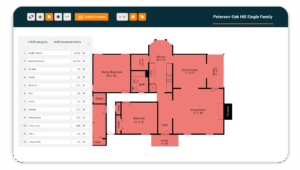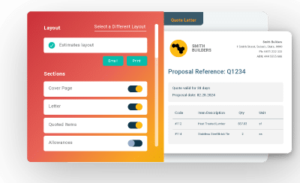The current housing market has seen consumer demand and construction activity shift due to stubbornly high construction prices, high interest rates and low supply of existing homes. Despite these challenging developments, successful builders and general contractors continue to focus on subcontractor management practices to keep their businesses growing and the project manager happy.
Also, builders like you have noticed, in response to recent developments, many homeowners now opt for a remodel instead of a new build. In fact, 79% of homeowners say they would renovate before buying a new home, according to a recent Discover Home Loans survey of the construction industry as reported by Better Homes & Gardens.
With new home builds and remodels still in demand, builders and project managers need to be ready to estimate and quote jobs to a project owner as quickly as possible. Successful builders know that to maintain responsiveness to the customer requires them to act as an efficient project manager that has a keen sense of the project timeline. They must improve their overall efficiency and focus on specialized areas such as subcontractor management.
Builders need their labor networks to be ready and able to accept work and have the agility to steadily move from job-to-job. When doing so, you keep your subcontractor relationships fresh and avoid scrambling for skilled workers amid ongoing labor shortages. Skilled labor is key to subcontractor performance and project success.
Subcontractor management processes and benefits
There are many tasks involved with the successful completion of construction projects. Framing, hanging drywall, painting and installing flooring are just a few of the jobs that benefit from a team of construction subcontractors.
In most cases, as a custom home builder or general contractor, you don’t pay benefits to a subcontractor to complete this type of work done. However, you still have project management issues to consider. You need to have clearly written terms and conditions that govern scope of work, safety standards, change orders, compensation and worker protections for your construction project.
You will also likely need to discuss with an attorney any subcontractor agreements that govern payroll taxes, liability, insurance and overall subcontractor performance. It’s important to get the negotiations right because subcontractor expenses often total three-fourths of the cost of a home build.
Also, in today’s market you need to properly plan and schedule the work done by subcontractors. You need to confirm subcontractor availability, and ensure that you are establishing clear communication so that project materials are onsite when the subcontractor needs them. Any delays in one subcontractor task can throw off the schedule for subsequent contractors and work teams. It’s also important to remember that rushing to catch up on a schedule can compromise safety standards.
That’s why it’s important to always have a high-level view of the progress each subcontractor is making on the jobs assigned to them. You need to offer timely and constructive feedback. The sooner you know a job is slipping from the agreed schedule, the quicker you can solve the problem so that it doesn’t impact all the subcontractors on your job site.
Finally, you need a centralized place to track and store subcontractor agreements, documentation of a subcontractor’s performance and subcontractor invoices. This is vital as you track costs against your budget and project milestones. Keeping subcontractors under cost control is critical to maintaining your profitability.
Use the right software to improve subcontractor management
Document control
Today, builders and construction subcontractors like you need to spend more time on the job ensuring quality work proceeds as planned. You have less time for critical administrative tasks like takeoffs and estimating. Modern software helps cut administrative time because there is less paperwork.
Imagine not having to thumb through stacks of paper and files looking for important documents. With modern software, important subcontractor management documents can be stored centrally online for easy reference. Builders can also assign work orders to specific subcontractors to document expectations and deadlines. Work orders also can be used when it comes time to review a subcontractor’s work.
Project management
Once you’ve won a job and arranged for material and labor, it’s time to schedule your project. Keeping track of multiple subcontractors and the associated subcontractor agreement can be difficult and is particularly important as the length of time it takes to complete a home increases. Because of current labor and material shortages, it takes more than eight months to complete a home.
But modern software can help you manage this. Advance software allows you to create custom schedules directly from job estimates so that nothing is forgotten and all third party vendors are considered. You can store schedules for all tasks in one place where dependencies and progress can easily be monitored at both a high level and in detail using graphical software tools. This helps foster collaboration.
The best software also allows you to schedule jobs to specific subcontractors and notify those subcontractors contractors by email or text from the same tool.
Cost tracking
Of course, a critical part of your subcontractor management beyond scheduling is ensuring your dealer delivers quality materials to your job site on time and under budget. In this way, you are acting as the general contractor for your home build.
Modern software again helps you and project managers like you. You can access software tools today that create budgets straight from your estimate so that you can compare actual costs to your estimates. A single tool allows you to create work orders and receipts that directly connect to your budget so that you can have real-time updates as your project progresses.
Using the right software also saves you the time and hassle of importing data into different spreadsheets by connecting to widely used accounting software such as Quickbooks or Xero.
How to quickly improve your subcontractor management process
Whether just starting out or a seasoned veteran, builders like you need to constantly reassess your relationship with subcontractors and the tools you are using to manage these important resources.
Today, builders like you are more frequently turning to modern software to assist them. Buildxact offers an all-in-one platform for performing takeoffs, estimating material and labor costs and generating project schedules.
Learn more about pricing or begin working today with our friendly team at Buildxact. Book a demo or start right away with a 14-day free trial.


















